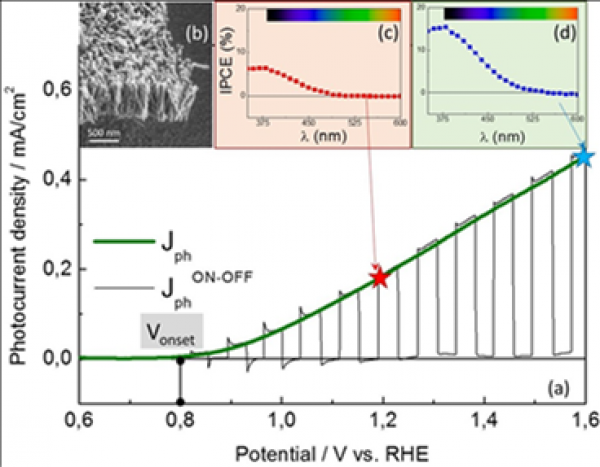Laboratoire Léon Brillouin
UMR12 CEA-CNRS, Bât. 563 CEA Saclay
91191 Gif sur Yvette Cedex, France
+33-169085241 llb-sec@cea.fr
Laboratoire Léon Brillouin
UMR12 CEA-CNRS, Bât. 563 CEA Saclay
91191 Gif sur Yvette Cedex, France
+33-169085241 llb-sec@cea.fr


In the framework of research on clean, secure and efficient energy, hydrogen production by solar water splitting is a very promising method. Overall efficiency of a solar water splitting process is directly related to local photo-electro-chemical reactions at the photo-electrodes-electrolyte interfaces that depend on the local environment defined by its morphology, chemical composition and electronic structure.
Since few years, we are interested by the hydrogen production by water splitting using oxide semiconductors as photo-anodes. Aqueous chemical growth (ACG) is used at SPEC / LNO to deposit nanostructured oxide films with thicknesses from tens to several hundreds of nm, it is more versatile and more appropriate for larger scale production.
In a first step, we obtain oxy-hydroxide (FeOOH) as-grown films. In a second step, phase transition occurs by air annealing in order to obtain the useful hematite phase. From SEM images obtained on akaganeite (FeOOH) and hematite (α-Fe2O3) films obtained by ACG we observe that the films grow as well-organized nanorods. Theirs orientations (spread out in all directions or perpendicular to the substrate similar to “carpet”- like film) is strongly dependent on deposition parameters and on substrate nature.
Photo-electro-chemical activity of these films used as photoanodes was characterized on solar water splitting setup at SPEC/LNO that allows the measurement: a) of the photocurrent density as a function of the external bias applied on the electrochemical cell, b) of the transient photocurrents evidenced by ON-OFF measurements and c) of the incident-photon-to-electron conversion efficiency (IPCE) as a function of the wavelength. (See below).

a) Photocurrent density vs. voltage for a Ti-doped hematite nanorods photoanode obtained by ACG. b) SEM image of carpet-like nanorods film. IPCE obtained at 1,2 V vs. RHE (c) and 1,6 V (d).
PhD students:
Bilal MEDDAS, “Oxygen evolution reaction at the interface between a semiconducting metal oxides and aqueous electrolyte during solar water splitting reaction”, 2024-2027 (funding ANR OERKOP)
Internship students:
Victoria VILLARD, internship M1: Physique et Applications, UPMC: “Synthèse des photo-anodes en solution aqueuse”, CEA – Saclay / DRF / IRAMIS / SPEC - CNRS UMR 3680 / LNO, 2017
Mekan PIRIYEV, M2: International Master Degree student in SERP+, Paris Saclay University: “Towards understanding the origin of the hematite photoanode optimization via Ti-doping for solar water splitting”, Synchrotron SOLEIL – CEA Saclay/DRF/IRAMIS/SPEC/LNO, 2019
Sara MAHFOUF, M2: Master Inorganic Chemistry, Paris Saclay University: “Graphite electrodes patterning decorated with hematite nanorods for solar water splitting liquid microcell fabrication”, Synchrotron SOLEIL – CEA Saclay/DRF/IRAMIS/SPEC/LNO, 2020
Théo ALUN, M1: Énergie renouvelables et efficacité énergétique, ESIEE Paris “Etude et optimisation des photoanodes nanostructurées d’hématite pour la production d’hydrogène par la photoélectrolyse de l’eau”, CEA – Saclay/DRF/IRAMIS/SPEC - CNRS UMR 3680/LNO, 2021
Basile BATAILLE, M2: Master PHYSMAN, PHYSico-chimie des Matériaux pour le Nucléaire et les énergies nouvelles, Université Claude Bernard, Lyon, “Caractérisation des photoanodes à base d’hématite par microscopie électrochimique à balayage pour l’oxydation de l’eau”, SPEC / ICMMO, 2023 (funding IES et SPEC)
Emma GAURY, M2: projet de fin d’étude, Ecole des Mines de Nancy, Université de Loraine, “Mesure de l’efficacité Faraday pour quantifier la production d’hydrogène par photoélectrolyse de l’eau”, SOLEIL / SPEC, 2023 (funding NanoSaclay, projet H2-re.SWSquant)
Asma TEGHRI, M2 : Matériaux fonctionnels et applications, Université Paris Saclay, “Microscopies de rayons X avancées appliquées à des photoanodes à base d’hématite”, SOLEIL, 2024 (funding NanoSaclay, projet H2-re.SWSquant)
References:
Fundings :
ANR project OERKOP (2023-2027): “Oxygen evolution reaction: the key to optimize photocatalytic water oxidation” ; https://iramis.cea.fr/spec/Phocea/Vie_des_labos/Ast/ast.php?t=projets&id_ast=3546
NanoSaclay projects (2021-2024):
- Faradaic efficiency measurement for a real quantification of H2 production by solar water splitting (H2re.SWSquant)
- Développement des photoanodes résistantes à la corrosion dans l’eau de mer pour une production d’hydrogène plus responsable (HYDROMER)
Contact CEA : Dana Stanescu from SPEC/LNO
•  Matériaux des nouvelles technologies pour l’énergie › Conversion de l'énergie
Matériaux des nouvelles technologies pour l’énergie › Conversion de l'énergie
• UMR 3680 - Laboratory of Condensed Matter Physics (SPEC) • UMR 3680 - Service de Physique de l'Etat Condensé (SPEC)
• Laboratoire Nano-Magnétisme et Oxydes (LNO)
• Banc de mesure de la photo-électrolyse de l’eau / spectroscopie d’impédance
